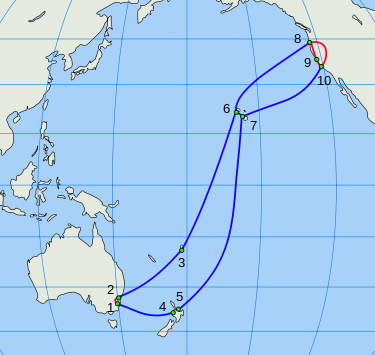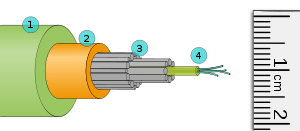Southern Cross Cable
| Cable type | Fibre-optic |
|---|---|
| Fate | Active |
| Construction beginning | 1998 |
| Construction finished | 2000 |
| First traffic | 2000 |
| Design capacity | >6000 Gbit/s (Jan 2012, based on 40G Technology) |
| Lit capacity | 5.4 Tbit/s (June 2016)[1] |
| Built by | Alcatel-Lucent/Fujitsu |
| Area served | Southern Pacific |
| Owner(s) | Southern Cross Cables Limited (Spark NZ (50.01%), Singtel/Optus (39.99%), Verizon Business (10%)) |
| Website |
www |

The Southern Cross Cable, operated by Bermuda company Southern Cross Cables Limited, is a trans-Pacific network of telecommunications cables commissioned in 2000.
The network has 28,900 km of submarine and 1,600 km of terrestrial fiber optic cables, operated in a triple-ring configuration. Initially, each cable had a bandwidth capacity of 120 gigabit/s,[2] but was doubled in an upgrade in April 2008,[3] with a further upgrade to 860 gigabit/s at the end of 2008.[4] Southern Cross upgraded the existing system to 1.2 Tbit/s in May 2010.[5] After successful trials of 40G technology the first 400G of a planned 800G upgrade has been completed in February 2012, with the remaining 400G completed in December 2012.[6] An additional 400G was deployed utilising 100G coherent wavelength technology in July 2013, taking total system capacity to 2.6Tbit/s, with an additional 500Gbit/s to be deployed per segment by Q2 2014, increasing total system capacity to 3.6Tbit/s.
The latest augmentation will also deploy Ciena FlexiGrid technology, increase Southern Cross potential capacity to 12 Tbit/s. Southern Cross offers capacity services from STM-1 to 100Gbit/s OTU-4, including 1G, 10G and 40G Ethernet Private Line services.
Landing points
- Alexandria, NSW, Australia
- Brookvale, NSW, Australia
- Suva, Fiji
- Whenuapai, New Zealand
- Takapuna, New Zealand
- Kahe Point, Oahu, Hawaii, United States
- Samuel M. Spencer Beach, Hawaiʻi island, Hawaii, United States
- Nedonna Beach, Oregon, United States
- Morro Bay, California, United States
Access points
- Equinix, Sydney, New South Wales, Australia (terrestrial connection only)
- Westin Building, Seattle, Washington, United States (terrestrial connection only)
- CoreSite, San Jose, California, United States (terrestrial connection only)
Network segments
The network comprises 12 segments (length of segment in brackets):
Submarine
- A. Alexandria-Whenuapai (2280 km)
- C. Takapuna-Spencer Beach (8000 km)
- D. Spencer Beach-Morro Bay (4135 km)
- F. Kahe Point-Hillsboro, Oregon (4540 km)
- G1. Suva-Kahe Point (5830 km)
- G2. Brookvale-Suva (3540 km)
- I. Spencer Beach-Kahe Point (460 km)
Terrestrial
- B. Whenuapai-Takapuna (15 km)
- E. Hillsboro, Oregon-Morro Bay (1590 km)
- E1. Morro Bay-San Jose (350 km)
- E2. San Jose-Hillsboro, Oregon (1600 km)
- H. Alexandria-Brookvale (30 km)

Topology
The network topology is configured to have redundant paths and be self-healing in case of physical damage.
In the cross section diagram shown:
- Insulating high density polyethylene (17 mm)
- Copper tubing (8.3 mm)
- Steel wires
- Optical fibers in water resistant jelly (2.3 mm)
Spying and interception
In 2013 the New Zealand Herald reported that the owners of the Southern Cross cable had asked the United States National Security Agency to pay them for mass surveillance of New Zealand internet activity through the cable.[7] In May 2014, John Minto, vice-president of the New Zealand Mana Party, alleged that the NSA was carrying out mass surveillance on all meta-data and content that went out of New Zealand through the cable.[7]
In August 2014, Russel Norman, New Zealand Green Party co-leader, stated that an interception point was being established on the Southern Cross Cable.[8] Norman said that as the cable is the only point of telecommunications access from New Zealand, this would allow the Government to spy on all phone calls and internet traffic from New Zealand.[8] Norman's claims followed the revelation that an engineer from the NSA had visited New Zealand earlier in the year to discuss how to intercept traffic on the Southern Cross cable.[8]
The office of John Key, New Zealand Prime Minister, denied the claims but admitted that they were negotiating a "cable access programme" with the NSA but refused to clarify what that was or why the NSA was involved.[8]
Damage incidents
There have been several incidents damaging sections of the Southern Cross Cable, in part due to it traversing the Pacific Ocean's Ring of Fire and its long length.
In late 2007, Southern Cross Cable's operations vice president, Dean Veverka, confirmed that hurricane strength storms and flooding had wiped out the carrier's Oregon cable route and halved its bandwidth between Australia/New Zealand/Fiji and United States. A Southern Cross customer (iiNet) said that emergency works have been organised to perform a more permanent fix for the damage to the cable. These works were performed on 3 February 2008 at 12 midnight AEST.[9]
In March 2008, the then head of Telecom Wholesale, Matt Crockett, mentioned to the National Business Review that there had been a recent undersea earthquake that destroyed a shunt on the Southern Cross Cable. However, due to the Cable's redundancy and spare capacity, users experienced no change in access or speed.[10]
Construction and ownership
Construction of the cable began in July 1999, laid by the ship CS Vercors, and the system was in use by customers by November 2000. Additional works and upgrades have since taken place to increase the network's capacity to 480 Gbit/s. In August 2007, SC Cables contracted with Alcatel-Lucent to upgrade the cable to 660 Gbit/s by the end of the first quarter 2008 and to 860 Gbit/s by the end of 2008, with future upgrade also by Alcatel-Lucent to 1.2 Tbit/s in May 2010.[11]
The company is owned by Spark New Zealand (50%), SingTel (40%) and Verizon Business (10%).[12]
Interconnected cables
The Tonga Cable System interconnects with Southern Cross Cable[13] in Fiji.
See also
- List of international submarine communications cables
- Other Australian international submarine cables (and year of first service):
- Pipe Pacific Cable (2009)
- Telstra Endeavour (2008)
- Australia–Japan Cable (2001)
- SEA-ME-WE 3 (2000, Australian portion in service earlier)
- JASURAUS (1997)
- PacRimWest (1995)
References
- ↑ "Overview and map". Southern Cross Cable Network.
- ↑ Southern Cross Cables Network
- ↑ Big Southern Cross Cable Upgrade for High Speed Broadband
- ↑ Southern Cross upgrades planned in 2008
- ↑ Broadband in for another price fall and capacity boost
- ↑ Southern Cross committed to Ultra Fast Broadband and National Broadband Network
- 1 2 John Minto (2014-05-14). "GCSB holding doors open while US buddies invade our privacy". New Zealand Herald.
- 1 2 3 4 "Govt called to account for spy claims". Radio New Zealand. 2014-08-01.
- ↑ iiNet status page: information regarding Southern Cross cable repairs
- ↑ Keall, Chris (6 March 2009). "Earthquake hits Southern Cross Cable". National Business Review. Retrieved 12 November 2011.
- ↑ Contract awarded to upgrade Southern Cross cable network: New technology will facilitate future upgrades up to 2.4 Tbit/s., Computerworld, accessed 24 August 2007
- ↑ "About Southern Cross". Southern Cross. Retrieved 9 July 2018.
- ↑ "Tonga Cable Launch". TongaCable. 21 August 2013. Retrieved 23 October 2013.